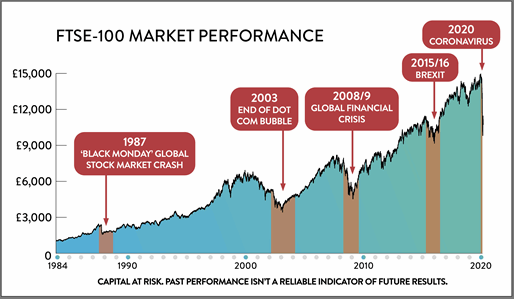Most of us are familiar with the term ‘stock market’, but what does it mean? Here’s a quick guide to help you understand how stock markets work.
What is the stock market?
The stock market is a place where people can buy and sell shares (or stock, they’re the same thing) – it kind of works like eBay, but instead of trading bikes or video games, you’re trading shares. There are two types of stock markets: primary and secondary. The primary market is when a company sells off its shares for the first time to investors. In the investment world, we commonly talk about initial public offerings, or IPO, and the purchase is often made through an investment bank which acts on behalf of the company. Now, if the investor wants to sell their shares, they’ll go to the secondary market – this is where shares of companies are bought and sold by secondary parties, whether they’re investment professionals or Bob from accounting. Any profit made between these sales will go to the investor, and not the company (or investment bank) which initially issued the stock. The price of shares on the secondary market will mainly be determined by the forces of supply and demand. In other words, if there are more buyers than sellers, prices will rise. And vice versa, if the number of sellers exceeds the number of buyers, prices will decrease.
The secondary market is made up of exchanges that are divided into indices – yes, it’s a bit confusing, but we’ll use an example to make this a bit clearer. For instance, in the UK you’ve got the London Stock Exchange which manages a number of indices like the FTSE 100, where the shares of UK companies (100 to be exact!) are traded every day. There are similar indices performing similar roles all over the world. In the US, you’ve got the S&P 500, in Japan, you’ve got the Nikkei, and in France, the main index is called CAC 40. This large number of indices across the globe means that there’s a wide range of investments you can purchase. And this is key when it comes to managing your investment risk. Indeed, if you want to try and mitigate risk, it’s important to consider spreading it across different investment types and regions, that way investments that perform poorly should be balanced out by others doing well. Having all these indices available allows you to diversify your portfolio and spread risk.
What is market volatility?
Stock market indices are a bit like roller coasters, they have ups and downs. Most of the time, markets will move steadily, but sometimes, they’ll swing fast and abruptly – this is what happens when markets crash, and we would typically talk about ‘high volatility.’ Volatility simply refers to market movements, and the size and speed of these fluctuations is a measure of how volatile markets are. For example, the start of 2020 saw markets around the world fall drastically – between February and March, the FTSE 100 dropped more than 30%1, marking the start of a new bear market (when share prices decrease for a sustained period of time). Here, the market dropped fast and far, indicating a high level of volatility.
So, what causes high volatility? Emotions! Investors are invariably human and needless to say, they can be quite emotional. The thing with emotions is that they can often lead to rash decisions. This is why people tend to sell their investments when times become a bit uncertain. And if there’s one thing investors despise, it’s uncertainty! So, when economies slow down, or political tensions break, or some new virus spreads across the globe, a sense of panic can take over markets as investors, motivated by the fear of losing money, will let their emotions control their decisions, with many of them selling their investments to try and reduce their losses. But by panic selling, all investors are doing is pushing share prices down, and as prices fall further, more nervous investors will hit the ‘sell’ button, deepening the crisis and driving volatility up. Although high volatility can be intimidating, it’s not necessarily bad news for investors. Yes, it typically comes with more risk, which could mean larger losses. But high volatility could also provide investors with opportunities - after all, high risk isn’t always synonymous with loss, it can also mean potentially higher gains.
What should you do when markets go down?
One thing’s for sure, seeing markets fall is never nice, but as an investor, it’s important to try and learn to live with the bumps. As mentioned earlier, markets are volatile by nature and downturns are more common than you may think. Take the FTSE 100 for example. In 2008, the UK index dropped by more than 30% (something that happened again in 2020 by the way). A year later, the FTSE 100 was back up 22.1%2. And that’s not the only time the FTSE 100 went down and up – here’s a graph showing how the UK index has performed since 1984.


See, bumps happen occasionally, so what can you do to try and shelter your investments from the turbulence? You could just keep your nerve and wait for the storm to pass. Obviously, we don’t have a crystal ball, and we can’t say for sure if markets will recover. But historically, most markets managed to bounce back. So, there’s every chance markets could recover, meaning if you stay invested during the storm, you could benefit from the potential rebound and make some tasty profits. If you do nothing and hold onto your investments, you’ll just see a red number on your dashboard and your losses will remain hypothetical. And did you know that the longer you remain in the game, the more likely you are to see positive growth? It’s true, people who invested in the FTSE 100 for any 10-year period between 1986 and 2019 have had an 89% of making a gain – and this is a timeframe that includes the Global Financial Crisis of 20083.
When markets crash, some investors choose to buy more. Why, you ask? Well, when markets go down, shares become cheaper to buy – it’s like there’s a sale on the stock market, so why not grab some potential bargains? By buying low, you could potentially sell high at a later point when stock markets recover, assuming they do bounce back eventually. A good way to take advantage of the falls would be to set up a monthly Direct Debit, that way your plan gets fed automatically and regularly, and you should be able to buy any potential bargains you see on the market.
Can you outperform the market?
Good question! Many investors pick their own investments to try and outperform the market – this strategy is known as ‘active investing.’ Put simply, you invest in a few companies you think could perform better than the market as a whole. Sounds simple, right? Well, it’s not that easy in practice, and many investors end up losing the competition. Although it’s possible to beat the market from time to time, it’s incredibly hard to outperform it constantly over the long-term. What’s more, picking potential winners often requires extensive research and analysis, meaning you’ll need to know a bit about investing and markets, before taking the plunge. If you’re too busy or don’t feel confident enough to do it by yourself, you could opt for actively managed funds. Investment funds are like hampers full of different investments which are prepared by investment professionals, known as fund managers. The particularity about active funds is that fund managers will hand-pick investments that are, in their opinion, more likely to beat the market. As previously mentioned, taking the active route isn’t without risk. Although you’re aiming for higher returns, there’s a chance you won’t manage to beat the market. And you’ve got to consider the cost of active investing as it’ll likely impact the performance of your portfolio. Typically, the total annual cost of owning an active fund and having an expert picking and managing your investments is on average 0.85%, so before committing, make sure you’re comfortable paying high fees to benefit from such expertise4.
If you’re not that keen on active investing, you could try the opposite and take the passive route. Since it’s very difficult to beat the market, it could be wise to just follow what the market’s doing. And this is exactly what you could be doing with passive funds. These funds are designed to mirror the collective returns of a stock market, rather than outperform it. Passive funds can track a specific market index, or they can follow a whole host of indices. Say, you buy a fund tracking the FTSE 100, your returns will follow the performance of the UK market. So, if the FTSE 100 goes down 10%, your investments will likely fall at a similar pace, and vice versa, if the market goes up 10%, your investments should follow and increase 10%. Obviously, this means that you’ll need to live with the ups and downs of the market - but remember, if you hold onto your investments over the long-term, you’ll likely see positive growth. And the advantage of passive funds is that they’re pretty cheap - the cost will vary between 0.20% and no fees4.
How to start investing in the stock market?
Now that you know a bit more about stock markets, why not dip your toe in the investment world? Getting started can feel intimidating, but it doesn’t have to be! With digital online platforms, like Wealthify, becoming an investor has never been easier. All you need to do is choose how much risk you’re comfortable with and how much you’d like to invest – you can start with as much or as little as you want. We’ll do the rest, from picking investment and monitoring markets, to managing your Plan on an ongoing basis and making adjustments when needed to keep it on track with your investment style.
References:
2: https://www.forecast-chart.com/historical-ftse-100.html
3: Data from Bloomberg
Past performance is not a reliable indicator of future results.
Please remember the value of your investments can go down as well as up, and you could get back less than invested.



